
An ice cream van (British) or ice cream truck is a commercial vehicle that serves as a cold-food specialty food truck or amobile retail outlet for pre-packaged ice cream, usually during the spring and summer. Ice cream vans are often seen parked at public events, or near parks, beaches, or other areas where people congregate. Ice cream vans often travel near where children play — outside schools, in residential areas, or in other locations. They usually stop briefly before moving on to the next street. Along the sides, a large sliding window acts as a serving hatch, and this often displays pictures of the available products and their prices. Most ice cream vans tend to sell both pre-manufactured ice pops in wrappers, and soft serve ice cream from a machine, served in a cone, and often with a chocolate flake, a sugary syrup, or toppings such as sprinkles. While franchises or chains are rare within the ice cream truck community, some do exist.

A food truck is a large motorized vehicle or trailer, equipped to storage, transport, cook, prepare, serve, and/or sell food. Historical predecessors of food trucks were horse-drawn chuck wagons and lunch wagons. Some, including ice cream trucks, sell frozen or prepackaged food; others have on-board kitchens and prepare food from scratch, or they heat up food that was prepared in a brick-and-mortar commercial kitchen. Sandwiches, hamburgers, french fries, and other regional fast food fare is common. By the early 2010s, amid the pop-up restaurant phenomenon, food trucks offering gourmet cuisine and a variety of specialties and ethnic menus became particularly popular. Food trucks may also sell cold beverages such as soda pop and water. Food trucks, along with food booths and food carts, are major components of the street food industry that serves an estimated 2.5 billion people every day.

Street food refers to food or drinks sold by a hawker or vendor on a street or at other public places, such as markets, fairs, and parks. It is often sold from a portable food booth, food cart, or food truck and is meant for immediate consumption. Some street foods are regional, but many have spread beyond their regions of origin. Most street foods are classified as both finger food and fast food and are typically cheaper than restaurant meals. The types of street food vary between regions and cultures in different countries around the world. According to a 2007 study from the Food and Agriculture Organization, 2.5 billion people eat street food every day. While some cultures consider it to be rude to walk on the street while eating, a majority of middle- to high-income consumers rely on the quick access and cheap service of street food for daily nutrition and job opportunities, especially in developing countries.

A snack bar usually refers to an inexpensive food counter that is part of a permanent structure where snack foods and light meals are sold.

A hot dog stand is a business that sells hot dogs, usually from an external counter. Hot dog stands can be located on a public thoroughfare, near a sports stadium, in a shopping mall, or at a fair. They are often found on the streets of major American cities. According to one report, some hot dog stands are paying up to $80,000 in rent for prime locations in Manhattan.
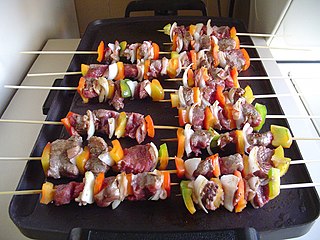
Honduran cuisine is a fusion of Mesoamerican, Spanish, Caribbean and African cuisines. There are also dishes from the Garifuna people. Coconut and coconut milk are featured in both sweet and savory dishes. Regional specialties include sopa de caracol, fried fish, tamales, carne asada and baleadas. Other popular dishes include meat roasted with chismol and carne asada, chicken with rice and corn, and fried fish with pickled onions and jalapeños. In the coastal areas and the Bay Islands, seafood and some meats are prepared in many ways, including with coconut milk. Among the soups the Hondurans enjoy are bean soup, mondongo soup, seafood soups and beef soups. Generally all of these soups are mixed with plantains, yuca, and cabbage, and served with corn tortillas.
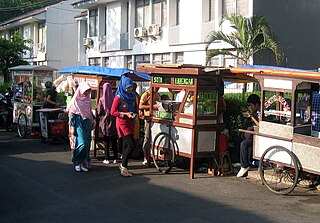
A food cart is a mobile kitchen set up on the street to prepare and sell street food to passers-by. Food carts are often found in cities worldwide selling food of every kind.

A food kiosk or food booth is generally a temporary structure used to prepare and sell food to the general public, usually where large groups of people are situated outdoors in a park, at a parade, near a stadium or otherwise. Sometimes the term also refers to the business operations and vendors that operate from such booths.

Mexican street food, called antojitos, is prepared by street vendors and at small traditional markets in Mexico. Street foods include tacos, tamales, gorditas, quesadillas, empalmes, tostadas, chalupa, elote, tlayudas, cemita, pambazo, empanada, nachos, chilaquiles, fajita and tortas, as well as fresh fruit, vegetables, beverages and soups such as menudo, pozole and pancita. Most are available in the morning and the evening, as mid-afternoon is the time for the main formal meal of the day. Mexico has one of the most extensive street food cultures in Latin America, and Forbes named Mexico City as one of the foremost cities in the world in which to eat on the street.

A hot dog cart is a specialized mobile food stand for preparing and selling street food, specifically hot dogs, to passersby. In some jurisdictions, a cart operator must meet stringent health regulations designed to protect the public. Hot dog carts are quick and easy food services, supplying millions of people with food every day. In 2015 the U.S. Hot Dog Council estimated that 15% of the approximately 10 billion hot dogs consumed by Americans in 2014 were purchased from a mobile hot dog vendor cart. Hot dog carts are very common in New York City, and most of the hot dogs purveyed by hot dog carts in New York City are sourced from Sabrett.

A field kitchen is a kitchen used primarily by militaries to provide hot food to troops near the front line or in temporary encampments. Designed to be easily and quickly moved, they are usually mobile kitchens or mobile canteens, though static and tent-based field kitchens exist and are widely used.
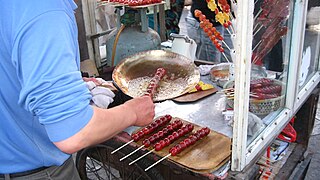
Regional street food is street food that has commonalities within a region or culture.
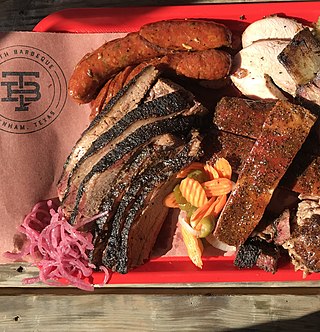
Texan cuisine is the food associated with the Southern U.S. state of Texas, including its native Southwestern cuisine influenced Tex-Mex foods. Texas is a large state, and its cuisine has been influenced by a wide range of cultures, including Tejano/Mexican, Native American, Creole/Cajun, African-American, German, Czech, Southern and other European American groups.

A taco stand or taquería is a food stall, food cart or restaurant that specializes in tacos and other Mexican dishes. The food is typically prepared quickly and tends to be inexpensive. Many various ingredients may be used, and various taco styles may be served. Taco stands are an integral part of Mexican street food. Tacos became a part of traditional Mexican cuisine in the early 20th century, beginning in Mexico City, as what had been a miner's snack began to be sold on street corners in the city. Shops selling tacos have since proliferated throughout Mexico and other areas with a heavy Mexican culinary and cultural influence, including much of the Western United States and most other larger American cities. More typical taquerías specialize in tacos, as expected, but in some localities it can be used to refer to restaurants specializing in burritos, where tacos themselves are less of a point of emphasis.
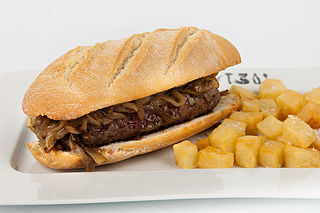
The pepito is a sandwich prepared with beef, pork, or chicken originating from Spain and also very popular in Latin America. It is a common street food in Venezuela and is also available at some U.S. restaurants. For the beef version, various cuts of beef are used, and myriad additional ingredients can also be used in its preparation.

Indonesian street food is a collection of ready-to-eat meals, snacks, fruits and drinks sold by hawkers or vendors at warung food stalls or food carts. Street food in Indonesia is a diverse mix of local Indonesian, Chinese, and Dutch influences. Indonesian street food are usually cheap, offer a great variety of food of different tastes, and can be found on every corner of the city.

Street food in Thailand brings together various offerings of ready-to-eat meals, snacks, fruits and drinks sold by hawkers or vendors at food stalls or food carts on the street side in Thailand. Sampling Thai street food is a popular activity for visitors, as it offers a taste of Thai cooking traditions. Bangkok is often mentioned as one of the best places for street food. In 2012, VirtualTourist named Bangkok as the number one spot for street food—the city is notable for both its variety of offerings and the abundance of street hawkers.

Colloquially referred to as Loncheras, Taco trucks have become an iconic symbol of Mexican culture in the United States. Popularized in Los Angeles, Loncheras are often characterized by rough exteriors, bright colors, and bold murals. Operators have been able to build loyal clientele using familiar parking spots, social media, and after-dark hours. Though taco trucks are a staple food for Angelenos of every race, Loncheras in Los Angeles are chiefly owned and operated by Hispanic and Latino families in low to moderate-income areas. Since Raul Martinez's first mobile truck success, taco trucks have continued to serve as windows of opportunity for migrant families and prospective chefs to earn a living. Taco trucks, like all Mexican street food, have allowed Mexican Americans to stay connected to their heritage while adjusting to a new country, community, and way of life. Success among authentic Mexican taco trucks later inspired "fusion taco trucks". Roy Choi's Kogi BBQ food truck, a Korean-Mexican short rib taco truck, is considered to be the first "fusion" taco truck in Los Angeles. The opening of Choi's truck marked a gastronomic explosion on the Los Angeles taco truck horizon. Both regular and fusion taco trucks help meet the high demand for fast, affordable, and convenient street food in the Golden city.





















